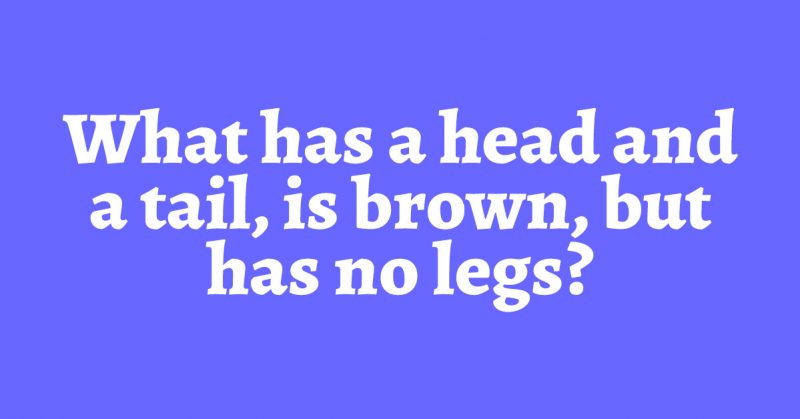Every now and then on social media, a particular riddle or puzzle will go viral, giving people a chance to test their logical power and exercise their brains. This one is actually pretty easy but a lot of people are guessing the most unimaginable answers.

What has a head and a tail, is brown, and has no legs?

Riddles, puzzles, brainteasers, and crosswords are some of the most interesting and productive activities to pass time, no matter how stomping or annoying they may be. The trick to solving a riddle is to go for the most obvious answer. It’s usually the right one. However, it’s easier said than done because our minds are wired to associate riddles with difficulty, so when a question comes up, we are immediately convinced the answer won’t be easy to find. While the extensive thinking and processing are especially great for a mental workout, to keep your patience in check, you might want to look at the question from a different and much simpler perspective.
Have you figured the answer out yet?
I’ll give you a few hints. It’s round, small, and you probably have a lot if it littered everywhere.
Do you see it now?
For me, solving riddles is a cheerful activity matter how many times I fail to get the answers right. It’s a win-win because I get to work out my brain and learn a few new things. Doing them regularly will sharpen your intuition over time and even if you keep flopping the riddles, you may get better at solving real-life problems. Riddles and puzzles have also been found to improve processing speed and sharpen memory [1]. While they may not exactly increase your IQ up to Einstein level, working regularly with these brain-teasing questions can fairly increase our intelligence level.
Puzzles and riddles are excellent for optimum brain health
The brain is the body’s control unit and over time, it begins to weaken from age and the death of nerve cells and neurons. Diseases that come with brain degeneration include all forms of dementia, and due to their progressive nature, they happen over variable periods of time.
Scientists have discovered that several factors may help to slow down or possibly prevent brain degeneration, some of which include a healthy diet, regular exercise, improving blood pressure and blood sugar, and most importantly, direct mental stimulation [2].
According to Harvard Medical School, research using mice and humans have proven that stimulating the brain may help to create new connections between nerve cells and possibly generate new neurons. This improves the brain’s elasticity and keeps it active for a longer time. It’s why parents are often advised to engage little children in mentally stimulating activities, and the same ideology works for aged persons.
Any activity that requires active brain processing is mentally stimulating. Of course, puzzles, riddles, brainteasers, crosswords, detective stories, math problems easily qualify as “mental gymnastics”.
Have you figured out the answer yet?
It has a head, a tail, is brown, but has no legs. Additionally, it is round, small, and probably littered everywhere in your home.
It’s a PENNY.
Voila! Proudly pat yourself on the back whether you got it right or not. At least, you learned something new.
References
- “7 Surprising Ways Puzzles Are Good for Your Brain.” Good Net. Retrieved October 5, 2020.
- “12 ways to keep your brain young.” Harvard Medical School. Retrieved October 5, 2020.

